Deepti Ghadiyaram
Facebook AI
Right Side Up? Disentangling Orientation Understanding in MLLMs with Fine-grained Multi-axis Perception Tasks
May 29, 2025Abstract:Object orientation understanding represents a fundamental challenge in visual perception critical for applications like robotic manipulation and augmented reality. Current vision-language benchmarks fail to isolate this capability, often conflating it with positional relationships and general scene understanding. We introduce DORI (Discriminative Orientation Reasoning Intelligence), a comprehensive benchmark establishing object orientation perception as a primary evaluation target. DORI assesses four dimensions of orientation comprehension: frontal alignment, rotational transformations, relative directional relationships, and canonical orientation understanding. Through carefully curated tasks from 11 datasets spanning 67 object categories across synthetic and real-world scenarios, DORI provides insights on how multi-modal systems understand object orientations. Our evaluation of 15 state-of-the-art vision-language models reveals critical limitations: even the best models achieve only 54.2% accuracy on coarse tasks and 33.0% on granular orientation judgments, with performance deteriorating for tasks requiring reference frame shifts or compound rotations. These findings demonstrate the need for dedicated orientation representation mechanisms, as models show systematic inability to perform precise angular estimations, track orientation changes across viewpoints, and understand compound rotations - suggesting limitations in their internal 3D spatial representations. As the first diagnostic framework specifically designed for orientation awareness in multimodal systems, DORI offers implications for improving robotic control, 3D scene reconstruction, and human-AI interaction in physical environments. DORI data: https://huggingface.co/datasets/appledora/DORI-Benchmark
Improving Physical Object State Representation in Text-to-Image Generative Systems
May 04, 2025Abstract:Current text-to-image generative models struggle to accurately represent object states (e.g., "a table without a bottle," "an empty tumbler"). In this work, we first design a fully-automatic pipeline to generate high-quality synthetic data that accurately captures objects in varied states. Next, we fine-tune several open-source text-to-image models on this synthetic data. We evaluate the performance of the fine-tuned models by quantifying the alignment of the generated images to their prompts using GPT4o-mini, and achieve an average absolute improvement of 8+% across four models on the public GenAI-Bench dataset. We also curate a collection of 200 prompts with a specific focus on common objects in various physical states. We demonstrate a significant improvement of an average of 24+% over the baseline on this dataset. We release all evaluation prompts and code.
What's in a Latent? Leveraging Diffusion Latent Space for Domain Generalization
Mar 09, 2025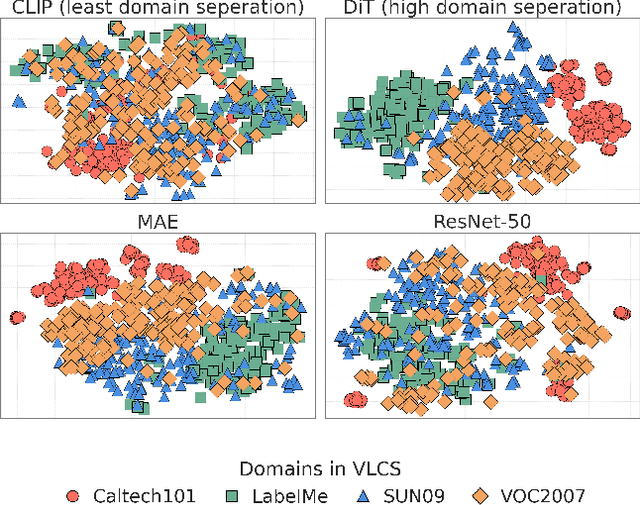

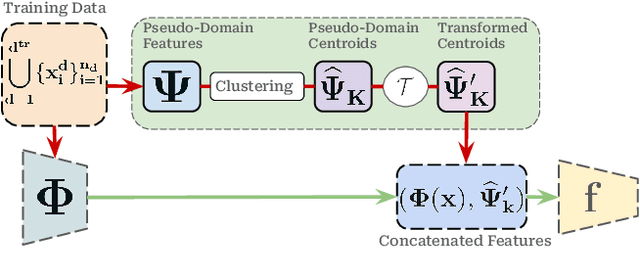

Abstract:Domain Generalization aims to develop models that can generalize to novel and unseen data distributions. In this work, we study how model architectures and pre-training objectives impact feature richness and propose a method to effectively leverage them for domain generalization. Specifically, given a pre-trained feature space, we first discover latent domain structures, referred to as pseudo-domains, that capture domain-specific variations in an unsupervised manner. Next, we augment existing classifiers with these complementary pseudo-domain representations making them more amenable to diverse unseen test domains. We analyze how different pre-training feature spaces differ in the domain-specific variances they capture. Our empirical studies reveal that features from diffusion models excel at separating domains in the absence of explicit domain labels and capture nuanced domain-specific information. On 5 datasets, we show that our very simple framework improves generalization to unseen domains by a maximum test accuracy improvement of over 4% compared to the standard baseline Empirical Risk Minimization (ERM). Crucially, our method outperforms most algorithms that access domain labels during training.
Concept Steerers: Leveraging K-Sparse Autoencoders for Controllable Generations
Jan 31, 2025


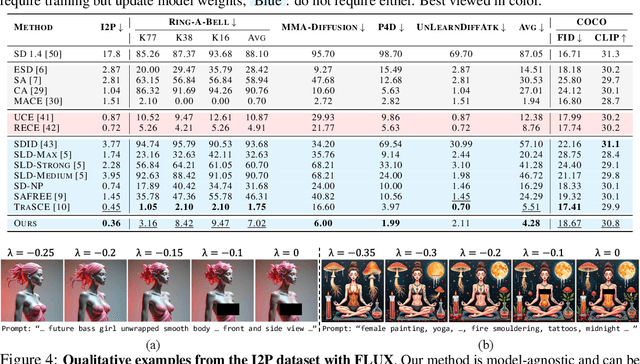
Abstract:Despite the remarkable progress in text-to-image generative models, they are prone to adversarial attacks and inadvertently generate unsafe, unethical content. Existing approaches often rely on fine-tuning models to remove specific concepts, which is computationally expensive, lack scalability, and/or compromise generation quality. In this work, we propose a novel framework leveraging k-sparse autoencoders (k-SAEs) to enable efficient and interpretable concept manipulation in diffusion models. Specifically, we first identify interpretable monosemantic concepts in the latent space of text embeddings and leverage them to precisely steer the generation away or towards a given concept (e.g., nudity) or to introduce a new concept (e.g., photographic style). Through extensive experiments, we demonstrate that our approach is very simple, requires no retraining of the base model nor LoRA adapters, does not compromise the generation quality, and is robust to adversarial prompt manipulations. Our method yields an improvement of $\mathbf{20.01\%}$ in unsafe concept removal, is effective in style manipulation, and is $\mathbf{\sim5}$x faster than current state-of-the-art.
DebiasPI: Inference-time Debiasing by Prompt Iteration of a Text-to-Image Generative Model
Jan 28, 2025



Abstract:Ethical intervention prompting has emerged as a tool to counter demographic biases of text-to-image generative AI models. Existing solutions either require to retrain the model or struggle to generate images that reflect desired distributions on gender and race. We propose an inference-time process called DebiasPI for Debiasing-by-Prompt-Iteration that provides prompt intervention by enabling the user to control the distributions of individuals' demographic attributes in image generation. DebiasPI keeps track of which attributes have been generated either by probing the internal state of the model or by using external attribute classifiers. Its control loop guides the text-to-image model to select not yet sufficiently represented attributes, With DebiasPI, we were able to create images with equal representations of race and gender that visualize challenging concepts of news headlines. We also experimented with the attributes age, body type, profession, and skin tone, and measured how attributes change when our intervention prompt targets the distribution of an unrelated attribute type. We found, for example, if the text-to-image model is asked to balance racial representation, gender representation improves but the skin tone becomes less diverse. Attempts to cover a wide range of skin colors with various intervention prompts showed that the model struggles to generate the palest skin tones. We conducted various ablation studies, in which we removed DebiasPI's attribute control, that reveal the model's propensity to generate young, male characters. It sometimes visualized career success by generating two-panel images with a pre-success dark-skinned person becoming light-skinned with success, or switching gender from pre-success female to post-success male, thus further motivating ethical intervention prompting with DebiasPI.
$\textit{Revelio}$: Interpreting and leveraging semantic information in diffusion models
Nov 23, 2024

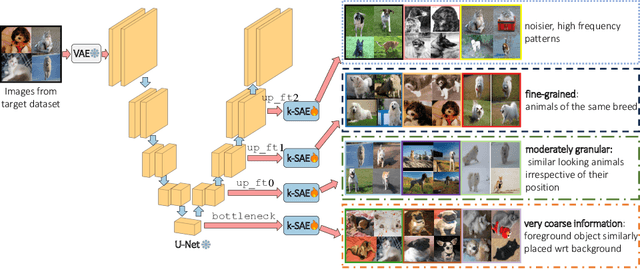

Abstract:We study $\textit{how}$ rich visual semantic information is represented within various layers and denoising timesteps of different diffusion architectures. We uncover monosemantic interpretable features by leveraging k-sparse autoencoders (k-SAE). We substantiate our mechanistic interpretations via transfer learning using light-weight classifiers on off-the-shelf diffusion models' features. On $4$ datasets, we demonstrate the effectiveness of diffusion features for representation learning. We provide in-depth analysis of how different diffusion architectures, pre-training datasets, and language model conditioning impacts visual representation granularity, inductive biases, and transfer learning capabilities. Our work is a critical step towards deepening interpretability of black-box diffusion models. Code and visualizations available at: https://github.com/revelio-diffusion/revelio
Mitigating stereotypical biases in text to image generative systems
Oct 10, 2023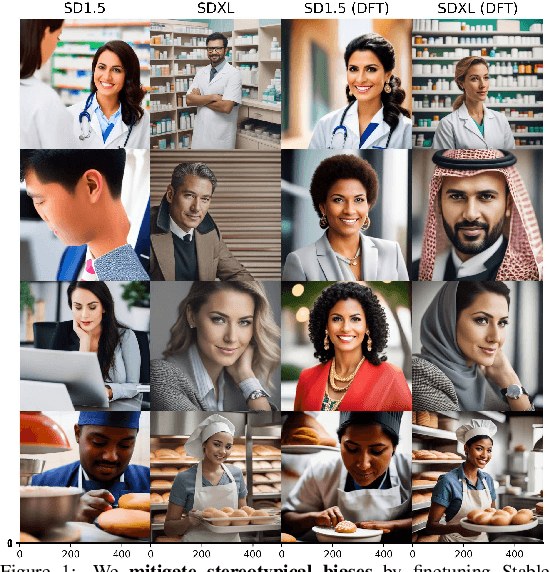


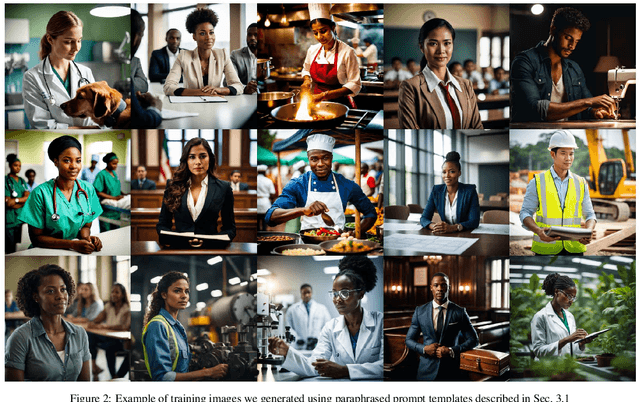
Abstract:State-of-the-art generative text-to-image models are known to exhibit social biases and over-represent certain groups like people of perceived lighter skin tones and men in their outcomes. In this work, we propose a method to mitigate such biases and ensure that the outcomes are fair across different groups of people. We do this by finetuning text-to-image models on synthetic data that varies in perceived skin tones and genders constructed from diverse text prompts. These text prompts are constructed from multiplicative combinations of ethnicities, genders, professions, age groups, and so on, resulting in diverse synthetic data. Our diversity finetuned (DFT) model improves the group fairness metric by 150% for perceived skin tone and 97.7% for perceived gender. Compared to baselines, DFT models generate more people with perceived darker skin tone and more women. To foster open research, we will release all text prompts and code to generate training images.
Helping Visually Impaired People Take Better Quality Pictures
May 14, 2023Abstract:Perception-based image analysis technologies can be used to help visually impaired people take better quality pictures by providing automated guidance, thereby empowering them to interact more confidently on social media. The photographs taken by visually impaired users often suffer from one or both of two kinds of quality issues: technical quality (distortions), and semantic quality, such as framing and aesthetic composition. Here we develop tools to help them minimize occurrences of common technical distortions, such as blur, poor exposure, and noise. We do not address the complementary problems of semantic quality, leaving that aspect for future work. The problem of assessing and providing actionable feedback on the technical quality of pictures captured by visually impaired users is hard enough, owing to the severe, commingled distortions that often occur. To advance progress on the problem of analyzing and measuring the technical quality of visually impaired user-generated content (VI-UGC), we built a very large and unique subjective image quality and distortion dataset. This new perceptual resource, which we call the LIVE-Meta VI-UGC Database, contains $40$K real-world distorted VI-UGC images and $40$K patches, on which we recorded $2.7$M human perceptual quality judgments and $2.7$M distortion labels. Using this psychometric resource we also created an automatic blind picture quality and distortion predictor that learns local-to-global spatial quality relationships, achieving state-of-the-art prediction performance on VI-UGC pictures, significantly outperforming existing picture quality models on this unique class of distorted picture data. We also created a prototype feedback system that helps to guide users to mitigate quality issues and take better quality pictures, by creating a multi-task learning framework.
Beyond web-scraping: Crowd-sourcing a geographically diverse image dataset
Jan 05, 2023



Abstract:Current dataset collection methods typically scrape large amounts of data from the web. While this technique is extremely scalable, data collected in this way tends to reinforce stereotypical biases, can contain personally identifiable information, and typically originates from Europe and North America. In this work, we rethink the dataset collection paradigm and introduce GeoDE, a geographically diverse dataset with 61,940 images from 40 classes and 6 world regions, and no personally identifiable information, collected through crowd-sourcing. We analyse GeoDE to understand differences in images collected in this manner compared to web-scraping. Despite the smaller size of this dataset, we demonstrate its use as both an evaluation and training dataset, highlight shortcomings in current models, as well as show improved performances when even small amounts of GeoDE (1000 - 2000 images per region) are added to a training dataset. We release the full dataset and code at https://geodiverse-data-collection.cs.princeton.edu/
Telepresence Video Quality Assessment
Jul 20, 2022
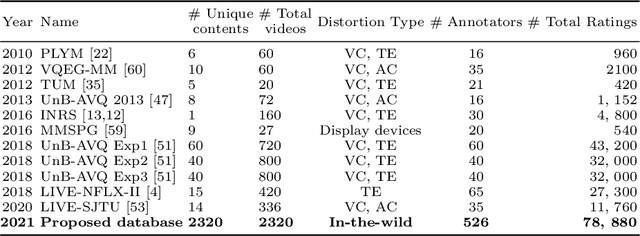

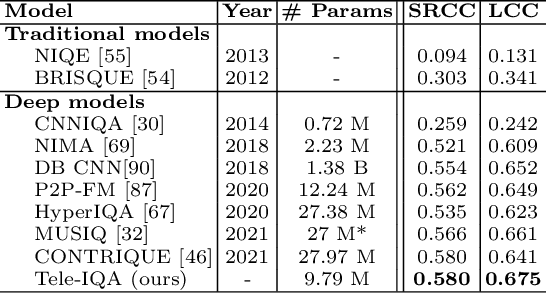
Abstract:Video conferencing, which includes both video and audio content, has contributed to dramatic increases in Internet traffic, as the COVID-19 pandemic forced millions of people to work and learn from home. Global Internet traffic of video conferencing has dramatically increased Because of this, efficient and accurate video quality tools are needed to monitor and perceptually optimize telepresence traffic streamed via Zoom, Webex, Meet, etc. However, existing models are limited in their prediction capabilities on multi-modal, live streaming telepresence content. Here we address the significant challenges of Telepresence Video Quality Assessment (TVQA) in several ways. First, we mitigated the dearth of subjectively labeled data by collecting ~2k telepresence videos from different countries, on which we crowdsourced ~80k subjective quality labels. Using this new resource, we created a first-of-a-kind online video quality prediction framework for live streaming, using a multi-modal learning framework with separate pathways to compute visual and audio quality predictions. Our all-in-one model is able to provide accurate quality predictions at the patch, frame, clip, and audiovisual levels. Our model achieves state-of-the-art performance on both existing quality databases and our new TVQA database, at a considerably lower computational expense, making it an attractive solution for mobile and embedded systems.
 Add to Chrome
Add to Chrome Add to Firefox
Add to Firefox Add to Edge
Add to Edge